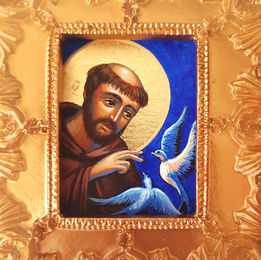top of page

Traditional Icons
In the ancient Christian past, colors that came from ground-up semi-precious stones, like lapis lazuli or cinnabar, would be worth close to or even more than gold. Such pigments produced the most luminous blues, reds, greens, and other colors that glorified God, but due to their high price, iconographers could not always afford these pigments for their work. Yet when they could, they have produced some of the most stunning results - from the Orthodox East's celebrated Holy Trinity icon of Andrei Rublev to the Catholic West's venerable St. Francis of Assisi frescoes of Giotto, which have inspired prayer and contemplation for centuries. And now, with greater accessibility to wide ranges of colors in the 21st century, Anna Poloz, taking the heart of this ancient desire to incorporate luminous colors in icons implements them into her own work. The luminosity of these colors celebrates the victory of God's love through His Incarnation, Death, and Resurrection and the victory of God's beauty that is embodied in the sanctity of His saints and angels.
Here, Anna Poloz created an array of icons that span from faithful copies to original compositions that are guided by historical iconographic predecessors of the Orthodox Church along with the Church's theology. Touches of influences from medieval Italian icons can be found there too, which stem from Anna's artistic formation in Florence, Italy where she lived and studied fine art and Byzantine iconography for 3 years.

bottom of page

























